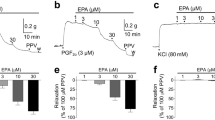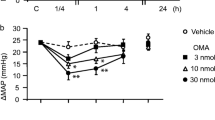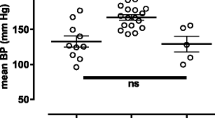Abstract
We investigated the constrictor effects of Angiotensin I (Ang I) and Angiotensin II (Ang II) on rabbit peripheral (aorta, carotid artery, mesenteric artery, saphenous artery) and cerebral (basilar artery) vessels and in rat aorta in functional organ bath studies. The effect of angiotensin converting enzyme (ACE) inhibition by captopril was also assessed in these preparations. Ang II elicited concentration-dependent contractions with comparable potency in rabbit and rat endothelium-free vascular rings (pD2 about 8.5) which indicates a lack of species and regional variation in the contractile responses to Ang II. The responses to Ang II were reduced by the presence of a functional endothelium in rabbit mesenteric artery and in rat aorta. Since ACE determines the plasma and tissue conversion of Ang I to active Ang II, we calculated the ratio R (EC50 Ang I-induced contraction: EC50 Ang II-induced contraction) as an indicator of the tissue ACE effectiveness. In the aorta without endothelium, Ang I was found to be much less potent than Ang II in the rabbit (R = 44) compared with the rat (R = 3.5). This species difference in the aortic conversion of Ang I to Ang II was confirmed by the use of captopril. Captopril (10−6M) shifted the Ang I concentration/response curve by 2- and 14-fold to the right in rabbit and rat respectively. In other rabbit blood vessels, the rank order of potency to Ang I in endothelium denuded rings was basilar artery ≫ carotid artery ≥ aorta ≥ saphenous artery. In addition, the R value was the lowest for the basilar artery (R = 2.5). This is in agreement with the highest rightward shift (78-fold) of the Ang I concentration/response curve by captopril for basilar artery in comparison with only 3-, 8- and 3-fold shifts observed in carotid artery, saphenous artery and aorta respectively. In conclusion, our data provide evidence for a greater influence of ACE in rabbit basilar artery than in peripheral vessels.
Similar content being viewed by others
References
André P, Scott C, Nehlig H, Stoclet JC (1990) Aortic smooth muscle cells are able to convert angiotensin I to angiotensin II. Biochem Biophys Res Commun 173:1137–1142
Antonaccio MJ, Normandin D, Ferrer P (1994) Reduced contractile function after balloon denudation of rat carotid arteries. Eur J Pharmacol 256:17–21
Arnal JF, Battle T, Rasetti C, Challah M, Costerousse O, Vicaut E, Michel JB, Alhenc-Gelas F (1994) ACE in three tunicae of rat aorta: expression in smooth muscle and effect of renovascular hypertension. Am J Physiol 267:H1777-H1784
Bullock GR, Taylor SG, Weston AH (1986) Influence of the vascular endothelium on agonist-induced contractions and relaxations in rat aorta. Br J Pharmacol 89:819–830
Caldwell PR, Seegal BC, Hsu KC, Das M, Soffer RL (1976) Angiotensin-converting enzyme: vascular endothelial localization. Science 191:1050–1051
Campbell DJ, Habener IF (1986) Angiotensin gene is expressed and differentially regulated in multiple tissues of the rat. J Clin Invest 78:31–39
Clozel JP, Hess P, Michael C, Schietinger K, Baumgartner HR (1991) Inhibition of converting enzyme and neointima formation after vascular injury in rabbits and guinea pigs. Hypertension 18(Suppl):II-55-II-59
De Meyer GRY, Bult H, Üstünes L, Kockx M, Jordaens FH, Zonnekeyn LL, Herman AG (1994) Vasoconstrictor responses after neo-intima formation and endothelial removal in the rabbit carotid artery. Br J Pharmacol 112:471–476
De Meyer GRY, Bult H, Kockx MM, Herman AG (1995) Effect of angiotensin converting enzyme inhibition on intimal thickening in rabbit collared carotid artery. J Cardiovasc Pharmac 26: 614–620
Démolis P, Carville C, Giudicelli JF (1993) Effects of an angiotensin-converting enzyme inhibitor, lisinopril, on cerebral blood flow autoregulation in healthy volunteers. J Cardiovasc Pharmac 22:373–380
D'Orléans-Juste P, Dion S, Mizrahi J, Regoli D (1985) Effects of peptides and non peptides on isolated arterial smooth muscles:role of endothelium. Eur J Pharmacol 114:9–21
Dzau VJ (1988) Circulating versus local renin angiotensin system in cardiovascular homeostasis. Circulation 77(Suppl 1) I-4-I-13
Dzau VJ, Ellison KE, Bordy T, Ingelfinger J, Pratt RE (1987) A comparative study of the distribution of renin and angiotensin messenger ribonucleic acids in rat and mouse tissues. Endocrinol 120:2334–2338
Eglème C, Cressier F, Wood JM (1990) Local formation of angiotensin II in the rat aorta: Effect of endothelium. Br J Pharmacol 100:237–240
Furchgott RF, Zawadzki JV (1980) The obligatory role of endothelial cells. in the relaxation of arterial smooth muscle by acetylcholine. Nature 288:373–376
Ganten D, Speck G (1978) The brain renin-angiotensin system: a model for the synthesis of peptides in the brain. Biochem Pharmacol 274:2379–2389
Ganten D, Hermann K, Unger T, Lang RE (1983) The tissue renin angiotensin system: focus on brain angiotensin, adrenal gland and arterial wall. Clin Exp Hypertens A5:1099–1118
Granger P, Dahleim H, Thurau K (1972) Enzyme activities of the single juxtaglomerular apparatus in the rat kidney. Kidney Int 1:78–88
Griffin SA, Brown WCB, MacPherson F (1991) Angiotensin II causes vascular hypertrophy in part by a non-pressor mechanism. Hypertension 17:626–635.
Gruetter CA, Ryan ET, Lemke SM, Bailly DA, Fox MK, Schoepp DD (1988) Endothelium-dependent modulation of angiotensin II-induced contraction in blood vessels. Eur J Pharmacol 146: 85–95
Hanson SR, Powell JS, Dodson T, Lumsden A, Kelly AB, Anderson JS, Clowes AW, Harker LA (1991) Effects of angiotensin converting-enzyme inhibition with cilazapril on intimal hyperplasia in injured arteries and vascular grafts in the baboon. Hypertension 18(Suppl):II-70-II-76
Ito S, Arima S, Ren YL, Juncos LA, Carretero OA (1993) Endothelium-derived relaxing factor/Nitric oxide modulates angiotensin II action in the isolated microperfused rabbit afferent but not efferent arteriole. J Clin Invest 91:2012–2019
Jarden JO, Barry DI, Juhler M, Graham DI, Strandgaard S, Paulson OB (1984) Cerebrovascular aspects of converting enzyme inhibition II: blood-brain permeability and effect of intracere-broventricular administration of captopril. J Hypertens 2:599–604
Juul B, Aslkjaer C, Mulvany MJ (1987) Responses of femoral resistance vessels to angiotensin in vitro. Eur J Pharmacol 135:61–68
Kikta DC, Fregly MJ (1982) Effect of in vitro administration of captopril on vascular reactivity of rat aorta. Hypertension 4:118–124
Kubo M, Fujitsuka T, Ishida R (1992) Effects of the new angiotensin-I-converting enzyme inhibitor imidapril on the responses of isolated vascular preparations to various agonists. Arzneimittelforschung Drug Res 42:446–451
Martin W, Furchgott RF, Villani GM, Jothianandan D (1986) Depression of contractile responses in rat aorta by spontaneously released endothelium-derived relaxing factor (EDRF). J Pharmacol Exp Ther 237:529–536
Morishita R, Gibbons GH, Ellison KE, Lee W, Zhang L, Yu H, Kaneda Y, Ogihara T, Dzau VJ (1994) Evidence for direct local effect of angiotensin in vascular hypertrophy. J Clin Invest 94:978–984
Ng KKF, Vane JR (1967) Conversion of angiotensin I to angiotensin II. Nature 216:762–766
Pagano PJ, Ito Y, Tornheim K, Gallop PM, Tauber AI, Cohen RA (1995) An NADPH oxidase superoxide-generating system in the rabbit aorta. Am J Physiol 68:H2274-H2280
Patel JM, Yarid FR, Block ER, Raizada MK (1989) Angiotensin receptors in pulmonary arterial and aortic endothelial cells. Am J Physiol 256:C987-C993
Paul M, Schunkert H, Allen P, Dzau VJ (1990) Widespread distribution of angiotensin converting enzyme mRNA in human tissues Abstract. J Hypertens 8(Suppl 3):S36
Pipili E, Manolopoulos VG, Catravas JD, Maragoudakis ME (1989) Angiotensin converting enzyme activity is present in the endothelium-denuded aorta. Br J Pharmacol 98:333–335
Powell JS, Clozel JP, Muller RK, Kuhn H, Hefti F, Hosang M, Baumgartner HR (1989) Inhibitors of angiotensin-converting enzyme prevent myointimal proliferation after vascular injury. Science 245:186–188
Postiglione A, Bobkiewicz T, Vinholdt-Pedersen E, Lassen NA, Paulson OB, Barry DI (1991) Cerebrovascular effects of angiotensin-converting enzyme inhibition involve large artery dilatation in rats. Stroke 22:1362–1368
Rakugi H, Kim D-K, Krieger JE, Wang DS, Dzau VJ, Pratt RE (1994) Induction of angiotensin converting enzyme in neointima after vascular injury. J Clin Invest 93:339–346
Robertson MJ, Cunoosamy MP, Clark KL (1992) Effects of peptidase inhibition on angiotensin receptor agonist and antagonist potency in rabbit isolated thoracic aorta. Br J Pharmacol 106: 166–172
Rogerson FM, Chai SY, Schlawe I, Murray WK, Marley PD, Mendelsohn FAO (1992) Presence of angiotensin converting enzyme in the adventitia of large blood vessels. J Hypertens 10:615–620
Ryan US, Ryan JW, Witaker C, Chin S (1976) Localization of angiotensin converting enzyme (Kininase II). II.Immunocytochemistry and immunofluorescence. Tissue Cell 8:125–145
Samani NJ, Swales JD (1991) Molecular biology of the vascular renin-angiotensin system. Blood Vessels 28:210–216
Saye JA, Singer HA, Peach MJ (1984) Role of endothelium in conversion of angiotensin I to angiotensin II in rabbit aorta. Hypertension 6:216–221
Story DF, Ziogas J (1986) Role of the endothelium on the facilitatory effects of angiotensin I and angiotensin H on noradrenergic transmission in the caudal artery of the rat. Br J Pharmac 87:249–255
Urabe M, Su C, Lee TJF (1987) Pre- and postsynaptic effects of angiotensins in the femoral artery of spontaneously hypertensive and Wistar-Kyoto rats. Blood Vessels 24:1–10
Vacher E, Forncs P, Domergue V, Richer C, Bruneval P, Guidicclli JF (1993) Quinapril prevents stroke both during and after the treatment period in stroke-prone spontaneously-hypertensive rats. Am J Hypertens 6:951–959
Van Heiningen PNM, Zwieten PA van (1993) Influence of the endothelium on Ca2+ dependency on angiotensin II-induced contractions of rat aortic rings. Fund Clin Pharmacol 7:227–233
Velletri P, Bean BL (1982) The effects of captopril on rat aortic angiotensin-converting enzyme. J Cardiovasc Pharmacol 4: 315–325
Veniant M, Clozel JP, Kuhn H, Clozel M (1993) Protective effect of cilazapril on the cerebral circulation J Cardiovasc Pharmacol 22 (Suppl 1):S30-S35
Wakabayashi I, Sakamoto K, Hakate K, Yoshimoto S, Kurahashi M (1990) Effect of age on contractile response to angiotensin II in rat aorta. Life Sci 47:771–779
Whalley ET (1987) Metabolism of bradykinin and angiotensin I by human basilar artery and rabbit aorta. Naunyn-Schmirredebdrerg's Arch Pharmacol 335:551–554
Whalley ET, Wahl M (1988) Cerebrovascular reactivity to angiotensin and angiotensin-converting enzyme activity in cerebrospinal fluid. Brain Res 438:1–7
Whalley ET, Fritz H, Geiger R (1983) Kinin receptors and angiotensin converting enzyme in rabbit basilar arteries. aNaunyn-Schmiedeberg's Arch Pharmacol 324:296–301
Wiemer G, Schölkens BA, Becker RHA, Busse R (1991) Ramiprilat enhances endothelial autacoid formation by inhibiting breakdown of endothelium-derived bradykinin. Hypertension 18: 558–563
Wilson SK, Lynch DR, Snyder SH (1987) Angiotensin converting enzyme labeled with [3H]captopril. Tissue localizations and change in different models of hypertension in the rat. J Clin Invest 80:841–851
Yen MH, Sheu YZ, Chiou WF, Wu CC (1990) Differential modulation by basilar and mesenteric endothelium of angiotensin-induced contraction in canine arteries. Eur J Pharmacol 180:209–216
Zhang J, Van Meel JCA, Pfaffendorf M, Zhang JS, Zwieten PA van (1994) Endothelium-dependent, nitric oxide-mediated inhibition of angiotensin II-induced contractions in rabbit aorta. Eur J Pharmacol 262:247–253
Zhang J, Pfaffendorf M, Zhang JS, Zwieten PA van (1995) Influence of the vascular endothelium on angiotensin II-induced contractions in rabbit renal artery. Fundam Clin Pharmac 9:25–29
Author information
Authors and Affiliations
Rights and permissions
About this article
Cite this article
Zerrouk, A., Auguet, M., Delaflotte, S. et al. Effects of angiotensin I and angiotensin II in blood vessels: greater influence of converting enzyme activity in the rabbit basilar artery. Naunyn-Schmiedeberg's Arch Pharmacol 354, 466–473 (1996). https://doi.org/10.1007/BF00168438
Received:
Accepted:
Issue Date:
DOI: https://doi.org/10.1007/BF00168438




